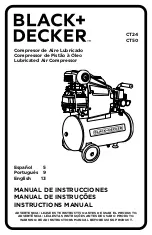
5
Before uncrating inspect the following:
• Check for possible damage in transit and see that the pulley turns freely and true by hand.
• Insure that adequate lifting equipment is available for unloading and moving your compressor.
• Once the compressor has been unloaded, check for concealed damage that could have occurred in transport.
• Read the compressor nameplate to verify proper model and size. Read the motor nameplate to be sure the motor is
compatible with your electrical supply.
•
NOTE: Standard motors are open drip-proof with a maximum ambient temperature rating of 40°C. They are not
suitable for salt-laden, corrosive, dirty, wet or explosive environments. Compressors can be ordered with specialty
motors.
• Check the receiver nameplate to be sure the tank is adequate for the pressure at which you intend to operate.
• As a measure of safety, read the pressure relief valve setting to be sure it does not exceed the working pressure of your
air system, or air receiver.
RECEIVING YOUR COMPRESSOR
FREIGHT DAMAGE
The entire transportation industry has adopted a modification with regard to the handling of concealed and obvious
damage claims; therefore, it is extremely important that you carefully examine every carton and crate as it comes in to your
place of business. If there is any visible damage to the shipping container, make absolutely certain the freight bill is so signed
by the delivering carrier and that you request a damage report. By handling in this manner, the damage will not be classified
as concealed and you will have no problem in making claim against the transportation firm. However, if the shipment is
accepted and then later you find that a part of the compressor has been damaged, this is classified as a concealed damage,
and the maximum time to report this damage is fifteen (15) days from time of acceptance of the freight.
Some important points to keep in mind are listed as follows:
1. With obvious damage, have the carrier make notation on freight bill at time of delivery. With concealed damage, notify
carrier within fifteen (15) days after delivery.
2. Contact carrier immediately to give them the opportunity to make an inspection of the shipment at your premises.
(With concealed damage this must occur within fifteen (15) days after delivery to the consignee.)
3. Retain containers and packing for inspection by the carrier.
4. Do not move shipments, which have been damaged, from point of carrier’s delivery to other locations, prior to
discovery and reporting of loss or damage and inspection of same.
5. Your claim should be filed with the delivery carrier within nine (9) months of the date the shipment was received, using
Standard Form for Presentation of Loss and Damage Claims. (
NOTE:
Damage must be reported within 15 days.
)
6. Your claim will need to be substantiated with the following documents:
a) Original bill of lading
b) Original paid freight (expense) bill
c) Original invoice or certified copy
d) Other particulars obtainable in proof of loss or damage
We suggest that these instructions be circulated to your shipping and receiving personnel.
Содержание RECIPROCATING
Страница 1: ...EAGLE RECIPROCATING COMPRESSOR MANUAL Congratulations on the purchase of your new Eagle Compressor ...
Страница 2: ...2 ...
Страница 15: ...15 TROUBLESHOOTING AND REPAIR ...
Страница 16: ...16 TROUBLESHOOTING AND REPAIR ...
Страница 17: ...17 TROUBLESHOOTING AND REPAIR ...
Страница 19: ...19 ...






































